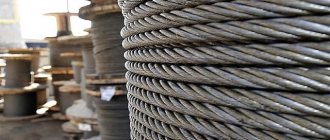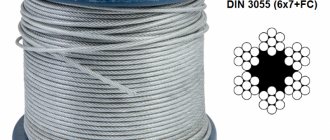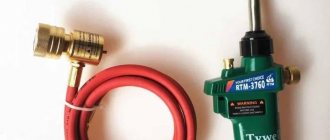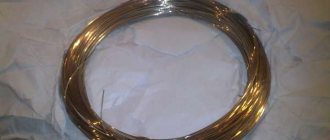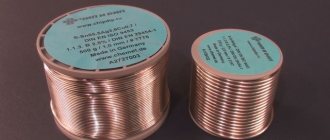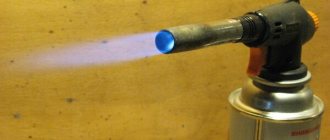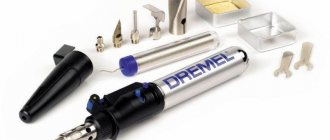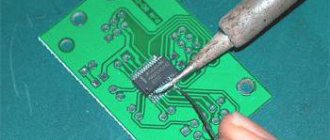What is solder?
Solder is a mixture of low-melting metals that are capable of providing good contact between two surfaces, resulting from soldering. When heated, solder changes from a solid to a liquid state, which ensures spreading around the perimeter of the soldered part or at the point of their contact. In this case, fixation occurs at the molecular level due to a high degree of adhesion.
In terms of composition, solders can include a variety of components that provide them with the necessary performance properties. However, the vast majority consists of a mixture of lead and tin, the first of which provides hardness and refractoriness, and the second lightness and lowers the melting point. The composition may also contain other components: silver, nickel, zinc, copper, kobold, bismuth, antimony and others.
Due to the multi-component composition, the melting process also goes through several stages: first, the most fusible components are rarefied, while the refractory ones remain in the form of crystals at this moment. Then they melt, the mixture becomes homogeneous and ensures maximum filling and contact. However, fluxes are used in conjunction with solder to provide better filling and oxidation protection.
Classification
All criteria for classifying solders represent a rather broad area, which, perhaps, can only be done by highly specialized specialists. Therefore, to simplify the selection, specific brands are made for specific purposes - soldering aluminum, jewelry, copper wire, radio components, etc. The main thing you should pay attention to is the temperature parameter. Since, for example, soldering a microcircuit cannot be done with the same brand of PIC as the connection of cable cores, since the sensitive component may burn out and fail.
Solders for soldering are classified according to the following criteria:
- according to the method of supplying flux - flux-free and self-fluxing, for the former the flux is supplied separately, for the latter they contain it in their composition;
Rice. 1. Self-fluxing and with flux feed
- according to the main soldering element - tin solders, nickel, cobalt, manganese, titanium, silver, zirconium, vanadium, mixed, etc.
- according to the method of production - they are ready-made or formed directly during soldering;
- according to the solubility of components - there are completely melted and partially melted;
- by release form - tin wire, rod, ingots, sheet, granules, paste;
Solder release form
- by melting point - there are those that turn into a liquid state at low and high temperatures.
When choosing tin-lead solder, the most important criterion is the last one, so we will dwell on it in more detail.
Low-melting (soft).
Low-melting solders include those compositions that turn into a liquid state at temperatures from 145 to 400°C. But, at the same time, they provide relatively low strength; for low-melting alloys, the tensile strength is no more than 7 kg/mm2. The most common are tin-lead. Most often, soft solders are used in electronics for printed circuit boards or parts.
Refractory (hard).
Hard solders have significantly greater mechanical strength, but their melting point is more than 400°C, which is unacceptable for most radio components, since they can be damaged even if touched by a heated soldering iron tip. The two largest groups in this category are copper and silver compounds. Copper alloys are generally combined with zinc, but are too brittle and are therefore suitable for carbide alloys that only experience static loading. Silver solders are universal and can be used for soldering any connection points, however, the cost of these brands is also quite high.
Solder pastes.
Solder pastes are also a component for soldering radio components, but they are used for small elements made of low-melting metal. The paste composition contains crushed pieces of solder in a solution of liquid flux. They are used in those boards or devices where exposure to high temperatures can harm the equipment. Pastes are typically soldered with a hairdryer without an electric soldering iron, or can simply be applied as a conductive adhesive.
The soldering mixture is applied to the point where the leads are attached in batches and can be done using a special stencil, syringe or drop-jet cartridge.
Fig 3. Applying solder paste with a printer, syringe, stencil
However, the use of soldering paste imposes a number of requirements that must be met:
- before opening the container, be sure to keep it at room temperature for at least 2 hours; using means of forced solder heating for this is prohibited;
- after opening, the mixture must be mixed until a homogeneous substance is obtained, since during storage the flux can separate from the solder;
Rice. 4. Stir until a homogeneous mixture
- before application, the surface must be cleaned of possible impurities and contaminants; during long-term soldering, the procedure is repeated every 45 minutes;
- installation of electronic components in the applied paste must be carried out within 60 minutes, otherwise it will begin to lose its properties;
- after soldering, the remains and excess paste are washed off, there are those that can be washed off with plain water, others require a solvent, some may not be washed off.
The functional characteristics of such solder are extremely negatively affected by placement in an environment with high or low temperatures, as well as exposure to moisture.
Lead-free solders.
Initially, the reason for creating lead-free solder was the need to eliminate harmful effects on the environment and the human body. Such solders are widely used for soldering aluminum or steel in the food industry, for drinking water supply pipes, laboratory equipment and tools.
In total, there are three most common groups of lead-free solders:
- tin with copper - used for high-temperature soldering, refers to refractory solders, well suited for working on copper products;
- tin and silver - suitable for low-temperature soldering, provide better contact than lead solders, but they are expensive.
- tin with both copper and silver is also a soft option, which has a lower cost than the previous one and is practically in no way inferior to it in the quality of connections.
- tin with bismuth and silver - can be used for soldering copper at low temperatures;
- tin with zinc and bismuth is a cheaper version of the previous one, but has a number of difficulties in use.
How to choose the right solder?
Correctly selected solder will help you organize a communication system of any complexity without much effort. If we are talking about working at home, it is worth using a material that melts at low temperatures.
The use of high-temperature hard-melting elements in everyday life is problematic, since it requires heating the working alloy to 600-900 degrees. Achieving this without special equipment is quite difficult.
Soldering of edible copper can be carried out using special solders that do not contain toxic, noxious and aggressive elements that can harm health
The use of metals and their derivatives that melt at high temperatures involves some risk. During processing, they can damage or even burn through thin-walled copper pipes.
To prevent this from happening, it makes sense to take strong but low-melting soft solder, and leave the hard option for thick-walled copper communications.
When large loads are not expected on the system, it is not at all necessary to use refractory solder, unless otherwise required. In basic household systems, soft light-alloy solders are sufficient to create a reliable connection.
To connect copper pipes in gas networks, you should choose silver-containing solders. They provide maximum seam strength, vibration neutrality and high resistance to external and internal influences.
You will have to pay a little more for silver, but the safety, reliability and durability of the system will pay off all financial costs over time.
Basic properties of solders
When choosing a specific brand of solder for soldering copper wires or aluminum alloys, you must be guided by their technical characteristics.
However, for all compositions a list of basic properties can be identified:
- wettability - shows how well the solder envelops and sticks to the parts being soldered;
- strength - determines the ability to withstand mechanical forces and loads; for this, boron, iron, nickel, zinc or cobalt can be added to the composition;
- plasticity - the ability to deform, achieved through additives from manganese, bismuth, lithium, etc.;
- resistance to high temperatures - important for soldering with hard alloys that are found in boiler rooms, furnaces, pipelines, heating devices, the property is achieved by adding tungsten, zirconium, vanadium, hafnium, niobium, etc.
- resistance to corrosion destruction - increases by alloying with copper or nickel.
Criterias of choice
When choosing any composition for tinning copper parts or soldering wires, it is important to take into account a number of factors that will affect both the quality of work and the result obtained.
Among these criteria, first of all, pay attention to:
- types of elements to be connected, what material they are made of, their thickness and parameters of the surfaces to be connected;
- soldering method for which solder is selected - with a copper tip of a classic soldering iron, a hair dryer, a soldering station, etc.;
- permissible temperature regime - the melting temperature of the solder must be less than the melting temperature of the elements being connected;
- the presence of mechanical impact - determined by static or dynamic, possibly vibration;
- resistance to aggressive environments - for premature destruction of solder, its type must provide resistance to moisture, temperature, gases, dust and other factors affecting it during operation.
Most used brands
The most popular types are POS solders, they are based on lead and tin, marked POS-40, 60, 80, etc., here the numerical designation indicates the percentage of tin. They are produced, as a rule, in the form of soldering wire; depending on the percentage of the main components, they can be classified as either low-melting or high-melting grades.
Used for soldering copper, aluminum, brass, bronze and other metals:
- POS-90 – well suited for the food industry;
- POS-40 - used for pipes and parts made of brass, iron, etc.;
- POS-30 – in cable connections;
- POS-61 – for working with radio components.
Of the silver-containing grades, solders often found are PSr-15, 25.45, 65, 70; the number after the letter indicates the percentage of silver. This type covers both copper soldering in high-precision instruments and the medical field.
Rose alloy, also called POSV-50, is one of the solders with the lowest melting point - from 90 to 100 ° C. Used in jewelry, soldering printed circuit boards, for fuse links, etc.
Rice. 5. Alloy Rose
What is the difference from POS 61
POS 40 melts at a temperature that reaches 238 degrees. This is a low temperature for the soldering area. That is why many people recommend the product in cases where the board contains parts that can be damaged by less fusible materials. More precisely, on the temperature that will have to be used to melt them.
As for POS 61 solder, it requires even less heating. That is why in cases where even the temperature required to melt POS 40 will be too high for a particular situation, this solder is recommended. So we can’t say that it’s worse, they just have different areas of application.

